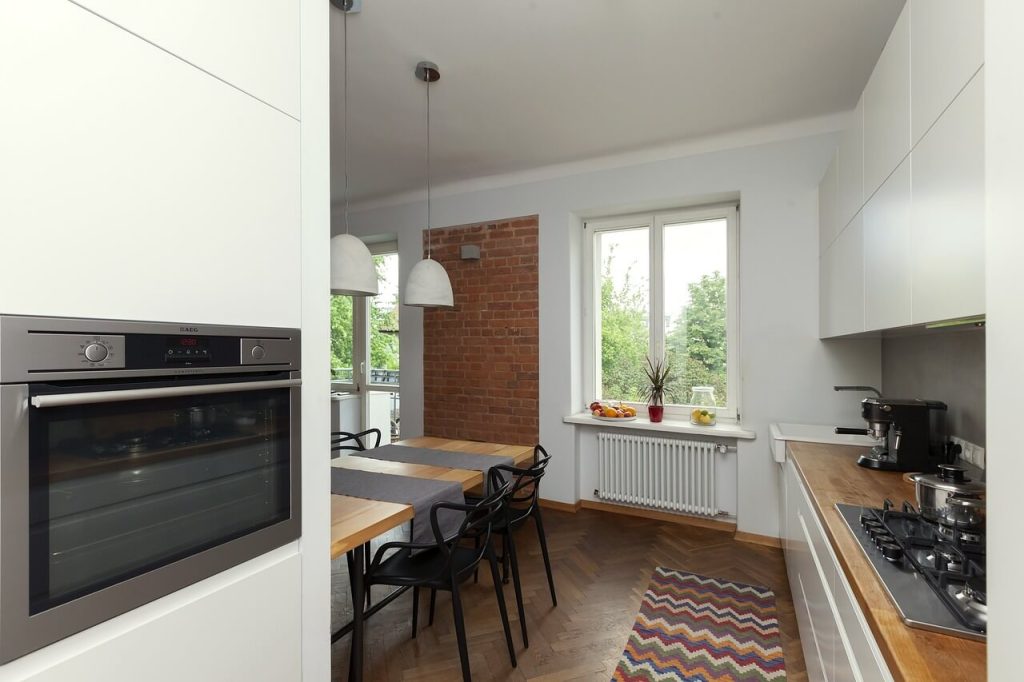If you like your indoor brick wall, but you feel that its color is not quite right, transform it with a little colored paint! In this article, I will tell you in detail how you can achieve a perfect result!
Brick is an incredibly durable building material for both interior and exterior spaces and requires minimal maintenance. It is also very fashionable among those who like rustic interiors. Sooner or later, however, brick may also need a bit of an update from dirt or to give it a new look with a coat of paint. Let’s also look at brick wall painting!
What is brick painting?
Brick painting changes the appearance and color of the brick in the same way as when we work with wall paint in the case of interior wall painting, only here we will use special interior brick paint. Brick paint is a mineral product that soaks into the brick and almost becomes part of the brick. It will not peel, bubble or peel off the brick. Sounds good, right?
Brick paint works best when applied to unsealed, clean, fully porous brick. Therefore, this method cannot be applied to bricks that have already been painted, because it cannot penetrate the porous material of the brick. If the wall was previously treated with plain paint, then unfortunately you can only think about plain paint now. But we hope that is not the case and you can apply brick paint. Now let’s get back to using the brick paint..
The special brick paint covers the surface of the brick with a thin color. This color can be opaque like plain paint or light and thin to preserve the base color and texture of the brick. Said brick paint seeps into the pores of the brick and allows the brick to breathe. One of the disadvantages of brick painting with brick paint is that any damage or stains can still be seen on the brick, especially through the paint on the brick.
You will need the following equipment for brick painting
- Clean bucket
- Brush
- Wooden mixing stick
- Scrub brush with nylon bristles
- Waterproof gloves
- Drip cloth
- Goggles
- Pronounced brick paint
- Mild detergent
Brick painting steps: How to paint brick wall interior
First, find a brick in an inconspicuous place and test the brick paint on it. Wait until the top is completely dry and check the color to see if you like it and would like to see it on the entire wall.
Brick test before painting!
He dropped a few drops of clean water on the brick. If the water seeps in immediately, it means that there is no sealant, a previous layer of paint on the brick. This means that you can use the special brick paint. If the water does not seep into the brick, unfortunately, you can only paint it over with traditional paint or wash the brick with a high-pressure washer to remove the sealant from the exterior surface of the brick (to avoid damage to the brick). Problem areas can be carefully scrubbed with a metal brush. Then test the brick again using the water drop method. Generally, the inner, non-visible surfaces of the bricks are not sealed by previous layers of paint.
Clean the brick
Mix mild detergent with warm water. Clean the bricks from top to bottom by scrubbing them with the nylon bristle brush. Finally, rinse the brick with clean water. Allow the brick to dry for a full day before painting. If you clean the brick in the morning and the weather is warm and dry, by the end of the day the brick will be dry enough to paint.
Mix the brick paint with water
Mix the brick paint with water, according to the instructions for use of the special paint. Mix thoroughly until all the pigment is dissolved.
Take the paint to the brick
Dip the brush into the paint and run the brush over the brick in overlapping layers, making sure that the end result is an even layer.
Things to do after painting the brick
Drying time depends on temperature, humidity and air flow. In warm, dry, slightly windy conditions, the painted brick will feel dry almost immediately after application. In areas where the paint has pooled instead of seeping into the brick, it may take a day or two for the paint to dry to the touch. For particularly dense, accumulated areas, wipe off the excess with a clean cotton cloth.
Tips and information for painting brick
- Add the right amount of water to the brick paint to get a light and thin layer of paint.
- Start with a thinner layer, as it can always be darkened.
- As the paint pigment can settle quickly, stir the paint mixture often.
- Mortar absorbs paint more and faster than brick.

Interior brick and paint color combinations
When choosing between ideas for painting interior brick walls, we often see solutions where there is a single-colored, traditional wall surface next to the painted brick wall and the two go very well together, you just have to hit the right colors! As in the top picture, where the color of the original brick wall was preserved and the white walls and painted kitchen cabinet emphasize the rusticity of the brick. This combination gives modern house design and atmosphere to the kitchen, where there are not too many rustic elements.
I already mentioned above that the best paint for interior brick is the special brick paint. However, if the wall was previously painted with, for example, water-based wall paint, there is still a solution. In such cases, it is worth working with Sherwin-Williams ProClassic Waterborne Interior Acrylic Enamel paint for a perfect result.
Interior paint colors that go with red brick wall
Shades of white, gray and beige go best with red brick. Within these, just decide according to your own taste and based on what kind of atmosphere you want to give to the given room. If it’s a sunny room, you can even choose dark gray shades. In a windowless room, on the other hand, choosing white or other lighter colors may be ideal, so that the room does not become too dark and gloomy.
I hope that with my advice it will be easy to repaint the brick walls in your home, however, if you would rather entrust the task to a professional painter in the Saint Augustine area, feel free to call me for a free quote. Call now: 1(904)217-9681


